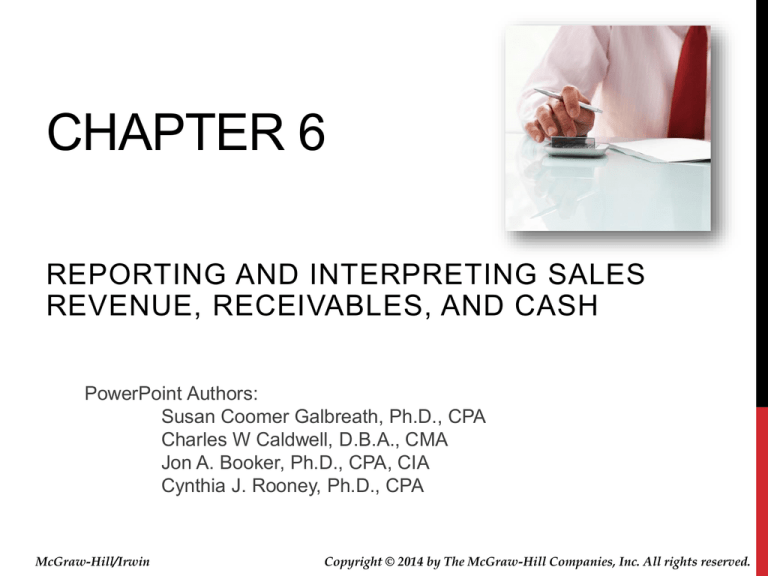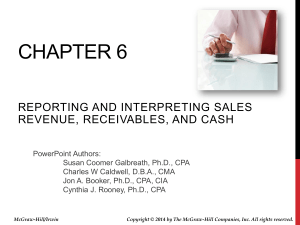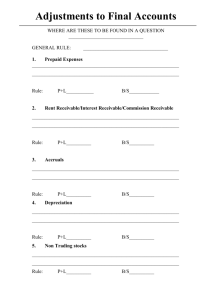
CHAPTER 6
REPORTING AND INTERPRETING SALES
REVENUE, RECEIVABLES, AND CASH
PowerPoint Authors:
Susan Coomer Galbreath, Ph.D., CPA
Charles W Caldwell, D.B.A., CMA
Jon A. Booker, Ph.D., CPA, CIA
Cynthia J. Rooney, Ph.D., CPA
McGraw-Hill/Irwin
Copyright © 2014 by The McGraw-Hill Companies, Inc. All rights reserved.
ACCOUNTING FOR NET SALES
REVENUE
The revenue realization principle requires that
revenues be recorded when earned.
Goods have been delivered or services
have been rendered.
There is persuasive evidence of an
arrangement for customer payment.
Price is fixed or
determinable.
Collection is
reasonably assured.
6-2
CREDIT CARD SALES TO
CONSUMERS
Companies accept credit cards for several reasons:
1. To increase sales.
2. To avoid costs of providing credit directly to customers.
3. To avoid losses due to bad checks.
4. To avoid losses due to fraudulent credit card sales.
5. To receive payment quicker.
When credit card sales are made, the company must pay the
credit card company a fee for the service it provides.
6-3
SALES DISCOUNTS TO BUSINESSES
When customers purchase on open account, they may be
offered a sales discount to encourage early payment.
Read as: “Two ten, net thirty”
6-4
TO TAKE OR NOT TO TAKE THE
DISCOUNT, THAT IS THE QUESTION
With discount terms of 2/10,n/30, a customer
saves $2 on a $100 purchase by paying
on the 10th day instead of the 30th day.
Interest Rate for 20 Days =
Amount Saved
Amount Paid
Interest Rate for 20 Days =
$2
$98
365 Days
20 Days
= 2.04%
× 2.04% = 37.23%
6-5
SALES RETURNS AND ALLOWANCES
Customers have a right to return unsatisfactory or
damaged merchandise and receive a refund or an
adjustment to their bill. Such returns are often
accumulated in a separate account called Sales
Returns and Allowances.
Damaged
Merchandise
Returned
Merchandise
6-6
REPORTING NET SALES
Companies record credit card discounts,
sales discounts, and sales returns and allowances
separately to allow management
to monitor these transactions.
Sales revenue
Less: Credit card discounts
Sales discounts
Sales returns and allowances
Net sales
6-7
MEASURING AND REPORTING
RECEIVABLES
Accounts receivable are
created when companies
have sales to customers
on open accounts.
Notes receivable are
written promises from
another party to pay with
specified terms.
Trade receivables are
amounts owed to the
business for credit sales of
goods or services.
Nontrade receivables are
amounts owed to the
business for other than
business transactions.
Balance Sheet Classifications
Current (short term)
Noncurrent (long term)
6-8
ACCOUNTING FOR BAD DEBTS
Bad debts result from credit customers who will not pay the
amount they owe, regardless of collection efforts.
Bad Debt Expense
Matching Principle
Record in same
accounting period.
Sales Revenue
Allowance
Method
Most businesses record an estimate
of the bad debt expense with an
adjusting entry at the end of the
accounting period.
6-9
RECORDING BAD DEBT EXPENSE
ESTIMATES
Deckers estimated bad debt expense for 2011 to
be $75,995. Prepare the adjusting entry.
Contra-asset account
Bad debt expense is normally classified as a selling
expense and is closed at year-end.
6-10
WRITING OFF SPECIFIC
UNCOLLECTIBLE ACCOUNTS
When it is clear that a specific customer’s account
receivable will be uncollectible, the amount should be
removed from the Accounts Receivable account and
charged to the Allowance for Doubtful Accounts.
Deckers’ total write-offs for 2011 were $68,075.
Prepare a summary journal entry for these write-offs.
6-11
SUMMARY OF THE ACCOUNTING
PROCESS
Accounting for bad debts is a two step process.
6-12
REPORTING ACCOUNTS RECEIVABLE
AND BAD DEBTS
6-13
ESTIMATING BAD DEBTS ─
PERCENTAGE OF CREDIT SALES METHOD
Bad debt percentage is based
on historical percentage of
credit sales that result in bad
debts.
6-14
ESTIMATING BAD DEBTS ─
PERCENTAGE OF CREDIT SALES METHOD
The focus of the percentage of credit
sales method is on determining the
amount to record on the income
statement as Bad Debt Expense.
6-15
ESTIMATING BAD DEBTS ─
AGING OF ACCOUNTS RECEIVABLE
The focus of the aging of
accounts receivable method is
on determining the desired
balance in the Allowance for
Doubtful Accounts on the
balance sheet.
6-16
ESTIMATING BAD DEBTS ─
AGING OF ACCOUNTS RECEIVABLE
6-17
CONTROL OVER ACCOUNTS
RECEIVABLE
Practices That Can Help Minimize Bad Debts
Require approval of
customers’ credit by a
person independent of
the sales and
collections functions.
Age accounts
receivable periodically
and contact customers
with overdue payments.
Reward both sales and
collections personnel
for speedy collections.
6-18
RECEIVABLES TURNOVER
This receivables turnover ratio measures how many times
average receivables are recorded and collected for the year.
Deckers 2011
6-19
FOCUS ON CASH FLOWS
Sales
Revenue
Add Decrease
in Accounts
Receivable
Subtract
Increase in
Accounts
Receivable
Cash Collected
from Customers
Excerpt from Cash Flow Statement
6-20
CASH AND CASH EQUIVALENTS
Money
Cash
Checks
Money
Orders
Bank Drafts
Cash
Equivalents
Certificates
of Deposit
T-Bills
6-21
CASH MANAGEMENT
Cash Management Procedures
Accurate accounting so
that reports of cash
flows and balances may
be prepared.
Controls to ensure
that enough cash is
available to meet current
operating needs,
maturing liabilities, and
unexpected
emergencies.
Prevention of the
accumulation of excess
amounts of idle cash.
6-22
INTERNAL CONTROL OF CASH
Internal control refers to policies and procedures designed to:
Safeguard
assets.
Provide
reasonable
assurance on
the reliability of
financial
records.
Provide
reasonable
assurance on
the
effectiveness
and efficiency
of operations.
Provide
reasonable
assurance on
the compliance
with laws and
regulations.
Cash is the asset most vulnerable to theft and fraud.
6-23
INTERNAL CONTROL OF CASH
Separate jobs of receiving cash and disbursing
cash.
Separation
of Duties
Separate procedures of accounting for cash
receipts and cash disbursements.
Separate the physical handling of cash and all
phases of the accounting function.
Require that all cash receipts be deposited in a
bank daily.
Policies and
Procedures
Require separate approval of the purchases and
the actual cash payments.
Assign responsibilities for cash payment approval
and check-signing to different individuals.
Require monthly reconciliation of bank accounts
with the cash accounts on the company’s books.
6-24
CONTENT OF A BANK STATEMENT
Interest Earned
(INT)
Electronic Funds
Transfer (EFT)
Not Sufficient
Funds (NSF)
Service Charge
(SC)
6-25
NEED FOR RECONCILIATION
Explains the difference between cash reported on bank
statement and cash balance on company’s books.
Reasons:
1. Timing Differences
a) Transactions recorded in the books but not shown
on the bank statement.
b) Transactions shown on the bank statement but not
recorded in the books.
2. Errors in Recording Transactions
Outstanding
Checks
Deposits in
Transit
Interest
Earned
Bank Service
Charges
NSF
Checks
Errors
6-26
BANK RECONCILIATION ILLUSTRATED
General Format of Bank Reconciliation
6-27
BANK RECONCILIATION ILLUSTRATED
Example of a Bank Reconciliation
6-28
BANK RECONCILIATION ILLUSTRATED
The bank reconciliation identifies previously unrecorded transactions or
changes that are necessary to cause the company’s Cash account(s) to
show the correct cash balance. Any transactions or changes on the
company’s books side of the bank reconciliation need journal entries.
6-29
CHAPTER SUPPLEMENT: RECORDING
DISCOUNTS AND RETURNS
Assume a credit card company is charging a 3 percent
fee for its service and Deckers' Internet credit card sales
are $3,000 for January 2.
Prepare the journal entry.
6-30
CHAPTER SUPPLEMENT: RECORDING
DISCOUNTS AND RETURNS
Similarly, assume that credit sales of $1,000 are
recorded with terms 2/10, n/30, and payment is made
within the discount period.
Prepare the journal entries.
6-31
CHAPTER SUPPLEMENT: RECORDING
DISCOUNTS AND RETURNS
Sales returns and allowances should always be treated as a
contra-revenue.
Assume that Fontana Shoes of Ithaca, New York, buys 40
pairs of sandals from Deckers for $2,000 on account. Before
paying for the sandals, however, Fontana discovers that 10
pairs of sandals are not the color ordered and returns them
to Deckers.
Prepare the journal entries.
6-32
END OF CHAPTER 6
6-33




